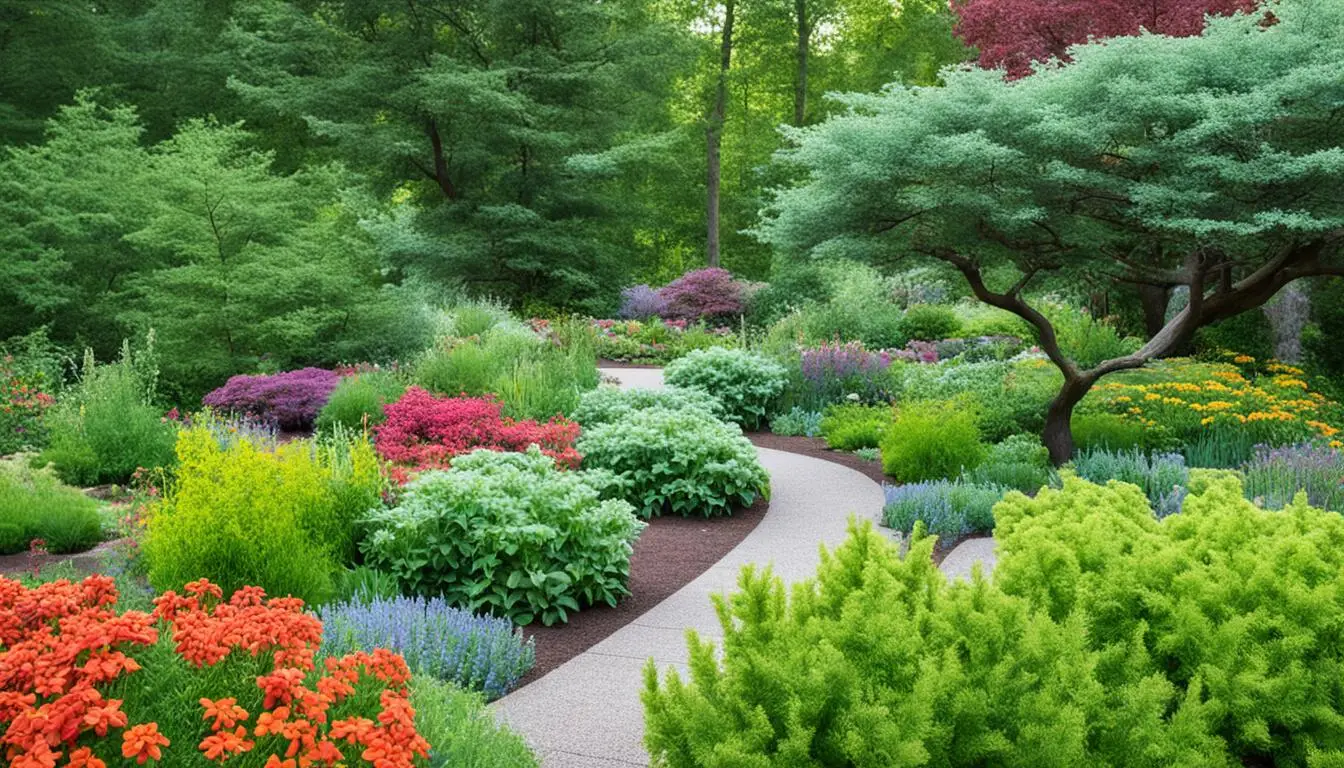Gardeners in the U.S. often see deer eat up their gardens. But you can fight back by planting deer resistance plants. These deer-proof plants are deterring due to their toxins, soft or strong-smelling leaves, and rough surfaces.
To keep deer away, experts recommend using deer-resistant plants. This approach avoids nasty chemicals and ugly fences. Instead, you replace favorite deer snacks with beautiful, low-maintenance plants. Deer stay away from these plants because they don’t taste good and might even be harmful. This approach makes your garden less appealing to them.
This guide highlights many options. From deer-resistant annuals and deer-resistant perennials to deer-resistant shrubs and deer-resistant ground covers, there’s something for everyone. Adding these plants creates a beautiful, deer-resistant garden. This can keep your space lush without being eaten by deer.
Key Takeaways
- Deer-resistant plants help create a thriving garden that deters hungry deer naturally.
- Many plants are unpalatable to deer due to their poisonous compounds, fuzzy/aromatic leaves, and tough/spiny textures.
- Deer tend to avoid plants with strong scents, tough foliage, and poisonous compounds.
- Choosing the right deer-resistant plants is key to keeping deer out of the garden naturally.
- Incorporating a variety of deer-resistant annuals, perennials, shrubs, and groundcovers can effectively discourage deer.
Introduction to Deer Resistant Gardening
Gardening fans often get frustrated when deer ruin their lovely garden. These beautiful animals eat flowers and plants, making a mess. It’s essential to keep deer out to protect your hard work.
Why Deer-Proof Your Garden?
Deer are becoming more common even in cities, causing trouble in gardens. They eat a lot and are hard to scare off. That’s why it’s important to use plants and methods that keep them away.
Benefits of Using Deer Resistant Plants
No plant can fully stop deer, but some are less tempting to them. Adding these plants to your garden reduces the damage they can do. You’ll spend less time worrying about your garden and more time enjoying it. Plus, it will look beautiful year-round. It’s a win-win!
Deer Resistance Plants
Selecting the right plants is crucial for a deer-resistant garden. By choosing flowers, shrubs, perennials, and groundcovers that deer tend to avoid, you create a barrier. For instance, marigolds are known for their strong smell, while plants like boxwood have spiky leaves. These features make deer avoid your garden.
Deer-Resistant Flowers (Annuals)
Annual flowers such as zinnias, verbenas, and snapdragons add fun colors. Their scents and different textures keep deer away. Your garden stays beautiful and deer-free all season.
Deer-Resistant Shrubs
Long-lasting shrubs like boxwood, potentilla, butterfly bush, and spirea are great choices. They have smells or feels that deer do not like. This means less work for you to keep deer out of your garden.
Deer-Resistant Perennials
Perennials like Russian sage, bee balm, and peonies are important for a deer-resistant garden. These unique plants prevent deer from eating your flowers. So, your garden can grow without deer interference.
Deer-Resistant Groundcovers
Groundcovers like pachysandra, ferns, and lady’s mantle form a shield. Placing them around your garden beds helps keep deer out. They also look nice, adding to your garden’s appeal.
Additional Deer Deterrent Strategies
Deer-resistant plants are key for a garden safe from deer. Adding more defense strategies improves your garden’s protection. Physical barriers, like fencing and netting, keep deer out. Make sure your fences are not easy to jump over.
Physical Barriers and Fencing
Fences should be at least 7 to 8 feet high for the best defense against deer. Use broad, rocky border beds as well. Deer don’t like to walk on large rocks. These strategies protect your deer deterrent garden and its plants.
Repellent Scents and Smells
Along with barriers, using smells can keep deer away. Dog urine or lights that turn on when they move can help. These steps make your garden less inviting to deer. It gives more deer browsing protection for your plants.

Designing a Deer-Resistant Landscape
Creating a garden that deer won’t eat starts with choosing the right plants. Gardens thrive when filled with deer-resistant flowers and such. This mix serves as a barrier that keeps deer away from your flowers.
Choosing the Right Plants
Selecting plants that deer don’t like is key. Look for those with strong smells or ones that feel rough. Add marigolds, snapdragons, and boxwood to your garden. These plants help keep deer at bay.
Creating Layered Defenses
A smart garden design combines the use of specific plants and barriers. Placing fences and dense shrubs can deter deer. This approach creates several hurdles that keep deer from your plants.
Incorporating Deer Deterrent Features
Aside from the right greenery, using deterrents boosts your garden’s safety. Things like motion lights or the scent of repellent plants can help. Even having dogs around can scare deer off.
Using plants, barriers, and deterrents together is the best defense. It creates a yard that’s not only safe but also beautiful. With these elements, your garden will thrive without being disturbed by deer.

Conclusion
In conclusion, it’s important to use deer resistant plants and other methods to safeguard your garden from deer. These steps are not a 100% guarantee but, when used together, they can keep deer away. Mixing deer-resistant plants with barriers and scents can make your garden a vibrant, deer-proof landscape. With the right choice of deer-resistant annuals, perennials, shrubs, and groundcovers, you can repel deer. This way, you can enjoy a beautiful garden without worrying about deer eating your plants.
Adding deer-deterrent plants and deer-repellent flora guards your garden and helps wildlife. Choosing plants that deer don’t like is the way to go. A garden with deer-discouraging plantings is not only attractive but also resists deer. This method creates a healthy deer-proof gardening space enjoyed by everyone.
The real secret to a successful deer-resistant garden is to use several strategies together. This includes the right plants and other defenses. With this approach, gardeners can make their yard a peaceful retreat again. They can bask in their garden’s beauty, knowing it’s well-protected from deer.
FAQ
Q: What are deer-resistant plants and how can they help protect my garden?
A: Deer-resistant plants keep deer away because they taste bad, feel weird, or smell strong. They make your garden full and healthy while keeping deer from eating your plants.
Q: What are the benefits of using deer-resistant plants in my garden?
A: They reduce the work you need to do in your garden and make your plants last longer. You can have a beautiful and safe garden without worrying about deer. These plants make your space less attractive to them.
Q: What are some examples of deer-resistant annual flowers, shrubs, and perennials?
A: Annuals like zinnias and marigolds, plus verbenas and snapdragons, are all good choices. Shrubs such as boxwoods and potentillas, and butterfly bushes and spireas are also deer-resistant. Perennials include Russian sage, bee balm, bleeding hearts, peonies, and monkshood.
Q: What other strategies can I use to deter deer from my garden?
A: Planting the right vegetation helps, but you can also use fences or rocks to keep deer out. Try scents like dog urine or use lights that turn on when they sense motion.
Q: How can I design a deer-resistant landscape?
A: Choose plants that deer don’t like for your garden’s different layers. Use fences, scents, and special features to make your garden a place deer avoid.






